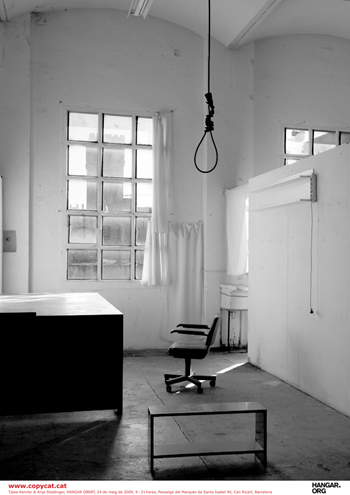 Copycat (2010), 25`
Copycat (2010), 25`
Short experimental documentary
written/directed/edited: Tjasa Kancler and Anja Steidinger
sound/music: Neda Ploskow
cast: Beatriz Vilaseca and Elisabet Sordé
interviews: Benigna Gerisch, Georg Fiedler, Claus Mewes, Carmen Tejedor, Alvaro Colomer
The history of suicide is a part of the philosophical tradition of questioning the “meaning of life” and has been defined, according to specific historical period, as a courageous, daring act, as a sin, as an act of the utmost freedom, or as an act of liberation from the modern life’s prison, in the words of Michel Foucault, as the usurpation of power.
In the postmodern age, the analysis of the meaning of suicide and death has become closely linked to recent political economy. Through the history of suicide the images associated with this issue are part of a system of cultural signs that play a crucial role in suggesting meaning and articulating questions about an apparently voluntary and symbolic act. We could say that the anonymity encompassed in the title of the Andy Warhol’s silkscreen, Purple Jumping Man, is in itself a recognition that a death by suicide is a characteristic of modern life and affects us all.
The Public Health Agency announced in November 2006 in its report that suicide is the leading cause of mortality in Barcelona within people from 15 to 44 years. In Spain, more than 3,500 people commit suicide each year, and around the world nearly one million. But the data does not end there. These figures take no account of the suicide attempts. It is estimated that for every suicide, there are at least 15 suicide attempts. The intensity of suicides depends on three following causes; individual predispositions, social organization and the passing events that disrupt the operation of collective life (economic crises, war etc. ..).An individual, apparently spontaneous act mostly meets social causes and reflects the characteristics of the society in which it occurs. The stronger is the imbalance of social factors, more subjects are predisposed to suicide and vice versa.
What is the relationship between personal conflicts and images and how does the mechanism of projection operate in this sense? What are the codes of visual language that construct representations of suicidal state or suicide? And to what extent can we understand suicide through such articulations?
Copycat is a short documentary about suicide. Through the re-enactment of some of the scenes from Roman Polanski’s film The Tenant, archive footage, film fragments and the interviews with a psychoanalyst, a psycologist, a psychiatrist, a writer and an art curator, the film focuses on the copycat effect to question media representation as well as psychological and social causes of suicide.
1_The Symposium “IMPRESSIÓ EXPANDIDA”/5-6.6.2009
2_HANGAR OBERT/24.5.2009
